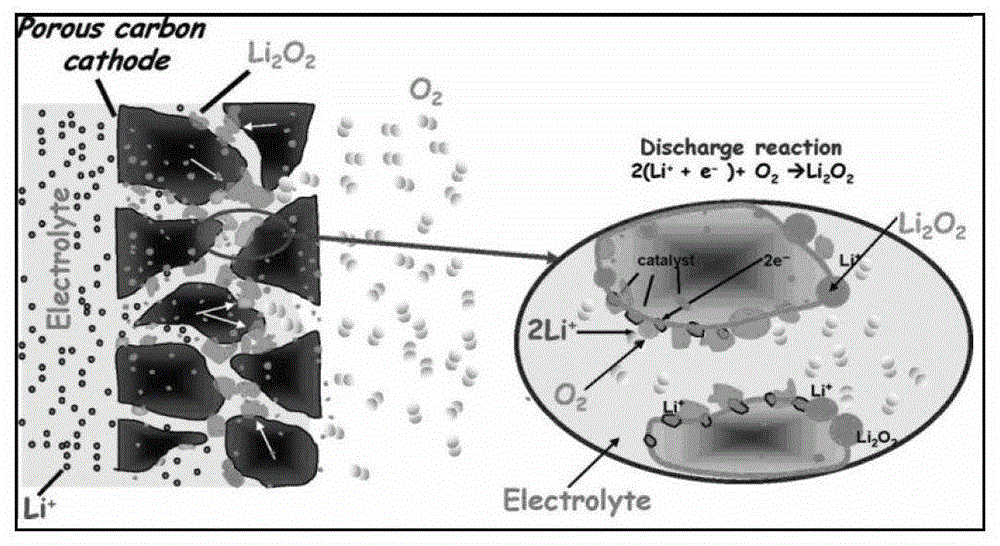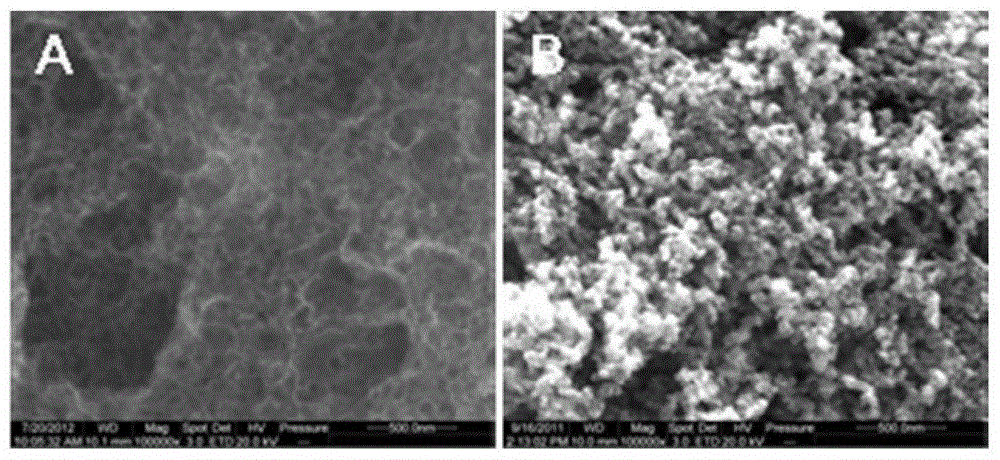Porous carbon materials for positive electrodes of lithium-air batteries
A porous carbon material, air battery technology, applied in battery electrodes, circuits, fuel cell type half cells and secondary battery type half cells, etc. Utilize the problems of space and the limited stacking thickness of discharge products to achieve the effect of improving space utilization, improving energy density and power density, and shortening diffusion distance
- Summary
- Abstract
- Description
- Claims
- Application Information
AI Technical Summary
Problems solved by technology
Method used
Image
Examples
Embodiment 1
[0029] Porous carbon materials with hierarchical pore structure were prepared by sol-gel method combined with template method. Dissolve 6.16g of resorcinol in 10mL of deionized water to form a transparent solution; take 2g of commercial SiO 2 Add the sol to the above transparent solution, mix and dissolve evenly to obtain a solution; add dropwise 9.08g of formaldehyde solution to the above stirring solution, stir and mix evenly, and continue stirring at 20°C until the reaction forms a gel; the gel Transfer to a vacuum drying oven, vacuum dry and age at 70°C for 7 days, take it out and grind to obtain a solid powder; put the solid powder in N 2 Treated at 900℃ for 3h, N 2 Purge to room temperature, 1M HF solution to wash away SiO 2 , that is, porous carbon materials with hierarchical pore structure.
[0030]The positive electrode material structure prepared in Example 1 has a large number of deposition pores with a diameter of 10 to 40 nanometers, and graded pores with 1 to ...
Embodiment 2
[0035] Porous carbon materials with hierarchical pore structure were prepared by sol-gel method combined with template method. Dissolve 6.16g of resorcinol in 10mL of deionized water to form a transparent solution; add 2g of nickel hydroxide powder to the above transparent solution, mix and dissolve to obtain a uniform solution; add dropwise 9.08g of formaldehyde to the above stirring solution The solution was further stirred and mixed evenly, and continuously stirred in an environment of 20°C until the reaction formed a gel; the gel was transferred to a vacuum drying oven and subjected to vacuum drying and aging treatment at 70°C for 5 days, and after taking it out, it was pulverized and ground to obtain a solid powder; the solid The powder was treated in Ar at 850°C for 3h, 1M HNO 3 The solution is washed to remove nickel oxide, filtered and dried to obtain the carbon material.
Embodiment 3
[0037] Porous carbon materials with hierarchical pore structure were prepared by sol-gel method combined with template method. Dissolve 6.16g of resorcinol in 10mL of deionized water to form a transparent solution; take 4g of aluminum oxide powder and add it to the above transparent solution, mix and dissolve evenly to obtain a solution; add dropwise 9.08g of For the formaldehyde solution, stir and mix evenly, and continue to stir in an environment of 20°C until the reaction forms a gel; transfer the gel to a vacuum drying oven for 2 days of vacuum drying and aging treatment at 70°C, take it out, crush and grind it, and obtain a solid powder; solid powder in N 2 Treat at 800° C. for 5 hours, wash away aluminum oxide with 2M HCl solution, and filter and dry to obtain the carbon material.
PUM
| Property | Measurement | Unit |
|---|---|---|
| pore size | aaaaa | aaaaa |
Abstract
Description
Claims
Application Information
 Login to View More
Login to View More - R&D
- Intellectual Property
- Life Sciences
- Materials
- Tech Scout
- Unparalleled Data Quality
- Higher Quality Content
- 60% Fewer Hallucinations
Browse by: Latest US Patents, China's latest patents, Technical Efficacy Thesaurus, Application Domain, Technology Topic, Popular Technical Reports.
© 2025 PatSnap. All rights reserved.Legal|Privacy policy|Modern Slavery Act Transparency Statement|Sitemap|About US| Contact US: help@patsnap.com


